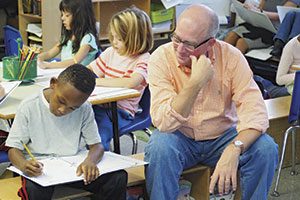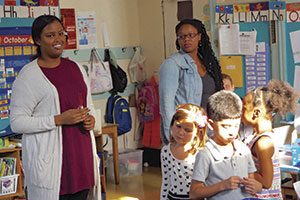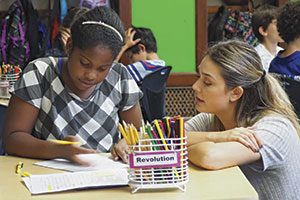This article originally appeared in the Summer 2017 issue of Syracuse University Magazine
 Last September, at Community Roots Charter School in Brooklyn, Nancy Ivanovic ’17 got to know a lively group of fifth-graders who helped her on her path to becoming a teacher. For weeks Ivanovic was a student teacher in their classroom, which was co-taught by a general education teacher and a special education teacher. The kids called themselves the “Energetic Pugs”—a nickname they created together through a collaborative exercise that helped establish a foundation for success in the school year ahead. “They went through a whole big voting process together with the teachers to come up with their identity,” says Ivanovic, an inclusive elementary and special education major in the School of Education. “It created an understanding that we’re a community and we’re in this together. And it got them excited to be in the classroom.”
Last September, at Community Roots Charter School in Brooklyn, Nancy Ivanovic ’17 got to know a lively group of fifth-graders who helped her on her path to becoming a teacher. For weeks Ivanovic was a student teacher in their classroom, which was co-taught by a general education teacher and a special education teacher. The kids called themselves the “Energetic Pugs”—a nickname they created together through a collaborative exercise that helped establish a foundation for success in the school year ahead. “They went through a whole big voting process together with the teachers to come up with their identity,” says Ivanovic, an inclusive elementary and special education major in the School of Education. “It created an understanding that we’re a community and we’re in this together. And it got them excited to be in the classroom.”
Taking part in that collaborative process was just one example of the benefits Ivanovic gained as one of 14 School of Education (SOE) teacher candidates who student-taught in New York City schools in 2016. The opportunity is made available to inclusive elementary and special education seniors each fall through the school’s Bridge to the City program, a partnership established in 2003 to provide a guided student-teaching experience in a dynamic urban environment and to connect New York City schools with SOE faculty, resources, and graduates. “The Bridge to the City program offers an expansive view of what urban schools are,” says Professor George Theoharis. “Many of our students have a real passion for urban education and see teaching as a form of changing the world and making it better and as a form of activism. This program provides them an educational experience that’s intense, powerful, and good for their development. They work really hard—and they love it.”
Students are placed in two different schools—ideally, one in Brooklyn and one in Manhattan, one a charter school and one a more traditional public school—spending seven weeks in a special education classroom and seven in a general education setting. The experience is the culmination of a rigorous teacher preparation program that requires teacher candidates spend approximately 900 hours in the field before they graduate. “By the time they begin student teaching, they are ready to take over,” says SOE director of field relations Thomas Bull G’90. “And in the schools we work with, they’re allowed to do that in really positive, constructive ways. We’ve formed strong relationships with some of the best schools in New York City—schools that are closely aligned with our philosophies, with what we teach here, and what we talk about in terms of best practice.”
The large number of schools in New York City allows SOE faculty to be selective in developing partnerships that best serve the program’s goals. “We look for strong commitments to inclusive education—of students with disabilities, but also strong commitments to racial, ethnic, and socioeconomic diversity,” says teaching and leadership professor Christy Ashby G’01, G’07, G’08. “And we look for places with constructivist orientations toward learning—thematic and experiential-based learning with an emphasis on faculty and staff collaboration.”
One important partner in the program is the Community Roots Charter School, whose co-founder and co-director, Sara Stone ’99, is an SOE alumna. The school consistently hosts SOE student teachers and has hired several alumni. “We believe that kids learn by doing, and we believe that kids learn when they feel included in a way that supports the unique type of learner that they are and the type of person they are and want to be,” says Stone, who values the ongoing connection with Syracuse made possible through the Bridge to the City program. “We opened with a commitment to inclusion and co-teaching in every classroom. Those foundational beliefs of integration and collaboration are reflected in the expectations we have for our kids, and certainly for our faculty.”
 For Ivanovic, student teaching in New York City provided living examples of all that is possible in education and affirmed her devotion to the field. “I loved the program and really owe a lot to it,” she says. “I always knew I wanted to be a teacher, but my way of thinking about teaching and my understanding of the power and weight and responsibility of my role as an inclusive educator have shifted. I’m excited to have my own classroom and help my students believe they can succeed.
For Ivanovic, student teaching in New York City provided living examples of all that is possible in education and affirmed her devotion to the field. “I loved the program and really owe a lot to it,” she says. “I always knew I wanted to be a teacher, but my way of thinking about teaching and my understanding of the power and weight and responsibility of my role as an inclusive educator have shifted. I’m excited to have my own classroom and help my students believe they can succeed.
Beyond the learning and experience gained through their student-teaching placements, Bridge to the City participants also enjoy the opportunity to become fully immersed in city life. They live together at the 92nd Street Y, a cultural hub that serves as a home away from home for university students from all over the world, and take classes at the Fisher Center, SU’s academic campus in midtown Manhattan. And in spite of very full schedules, they also find time to take advantage of all the city has to offer—from volunteering at the New York City Marathon and being part of the audience at Live with Kelly to going on class field trips to Carnegie Hall, the Met, and the New York Botanical Gardens. “One of the most exciting things for me was getting to see the city, not only for myself, but also through the eyes of my kids,” says Cora Cool-Mihalyi ’16, a University Scholar who completed an extra semester at SU to student-teach in New York. “And I learned a lot about myself—not just as a teacher, but also by being independent and navigating the city. It was kind of like living in New York City as a teacher for three months. It was amazing!”
 Another gift of the program is the supportive relationships students build—with one another, and with a network of School of Education alumni living and working in New York City. Those connections—as well as the strong reputation of the Bridge to the City program itself—can help pave the way for them as teachers starting out in the profession. “It’s all about getting students prepared so that, when they take that next step, they are confident and ready to go,” Bull says. “We’re all involved in the education field, so the more we can do to strengthen the field by preparing our students to be teacher leaders, the better.” —Amy Speach
Another gift of the program is the supportive relationships students build—with one another, and with a network of School of Education alumni living and working in New York City. Those connections—as well as the strong reputation of the Bridge to the City program itself—can help pave the way for them as teachers starting out in the profession. “It’s all about getting students prepared so that, when they take that next step, they are confident and ready to go,” Bull says. “We’re all involved in the education field, so the more we can do to strengthen the field by preparing our students to be teacher leaders, the better.” —Amy Speach
